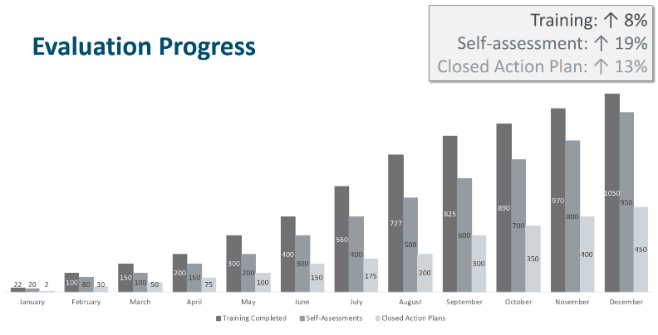Having a majority of employees working remotely is a new concept for most companies. Our previous post highlighted how online office ergonomics software can quickly and effectively reduce employee musculoskeletal disorders (MSDs) resulting from improper workstation setup, like carpal tunnel syndrome and neck or back pain, while improving employee productivity and work satisfaction.
Ergonomics software that lets employees learn, self-assess, and make improvements to their own workspaces also gives ergonomics process owners the ability to easily track overall success no matter where their workers are working. Here are three key metrics you should be tracking monthly.
1. Evaluation progress
All employees should complete ergonomics training that prepares them to properly adjust the equipment at their workstations. Next, each employee should have an ergonomics evaluation of his or her workstation. This can be conducted through an observational assessment, a self-assessment, or a remote consultation with an ergonomics professional. The evaluation identifies whether equipment recommendations are needed and emphasizes proper workstation setup. Lastly, there should be a process in place to review results, purchase equipment, and re-evaluate the workstation. Key measures to track include:
- How many employees have completed ergonomics training?
- How many employees have completed an ergonomics evaluation of their workstation?
- How many employees have completed their action plan?
2. Root causes and improvement status
Analyze the evaluation results to understand where the primary issues are occurring throughout the company or within departments. Ensure that employees are getting the equipment they need and that the equipment recommendations match the primary issues identified. Key measures to track root causes and improvement status include:
- What are the main issues identified?
- What percentage of improvements have been completed?
- What is the most common improvement recommended?
3. Risk reduction
It is critical to identify which employees have high MSD risk exposure; these cases are higher in priority to address. Based on the results of the ergonomics evaluation, document:
- What percentage of evaluations scored high, moderate, and low risk?
- What is the average risk reduction since last month?
- What is the average risk reduction year-to-date?
- What percentage of employees are experiencing discomfort
An Web-based software can help managers and leaders monitor the progress and success of the ergonomics process from anywhere around the world. Reviewing and tracking key metrics monthly will help
- identify meaningful trends in the data over time,
- help leaders identify next steps to drive the process, and
- track overall success of the ergonomics program.
Do you need help managing office ergonomics? If you lack the time or internal resources to effectively manage your office ergonomics process, VelocityEHS Office Ergonomics now offers a Managed Service. On a monthly basis, we can extract this and other data and present it to your management team. Contact our experts to learn more.
